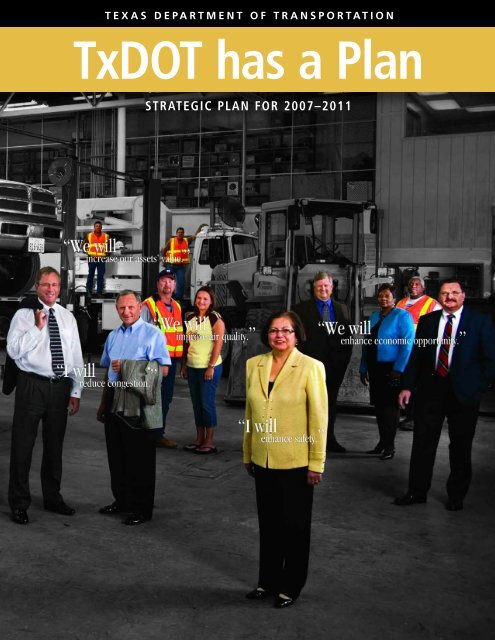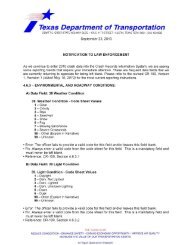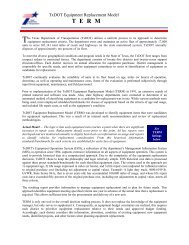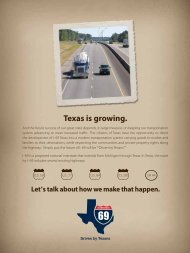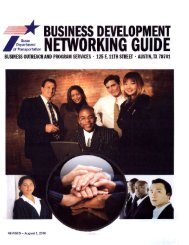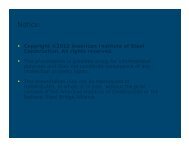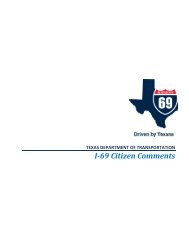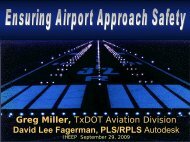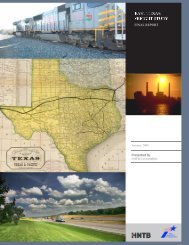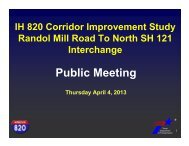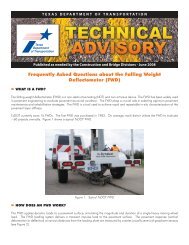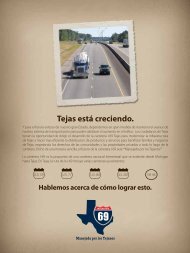TxDOT has a Plan - Welcome to the Texas Department of ...
TxDOT has a Plan - Welcome to the Texas Department of ...
TxDOT has a Plan - Welcome to the Texas Department of ...
You also want an ePaper? Increase the reach of your titles
YUMPU automatically turns print PDFs into web optimized ePapers that Google loves.
TEXAS DEPARTMENT OF TRANSPORTATION<br />
<strong>TxDOT</strong> <strong>has</strong> a <strong>Plan</strong><br />
STRATEGIC PLAN FOR 2007–2011
1. Mike Heiligenstein, Central <strong>Texas</strong> Regional Mobility Authority<br />
2. Jack Albert, Reece Albert, Inc.<br />
3. Rusty Davenport, Courtesy Patrol, Austin District, <strong>TxDOT</strong><br />
4. Norma Perales, TxTag Cus<strong>to</strong>mer<br />
5. Hope Andrade, <strong>Texas</strong> Transportation Commissioner<br />
6. Gerry Pate, Pate Engineers<br />
7. Alicia Taliaferro, Government & Business Enterprises Division, <strong>TxDOT</strong><br />
8. Ronald Crawford, Maintenance, Austin District, <strong>TxDOT</strong><br />
9. Ed Pensock, <strong>Texas</strong> Turnpike Authority Division, <strong>TxDOT</strong><br />
1<br />
2<br />
3<br />
4<br />
6<br />
7<br />
8<br />
9<br />
5
LETTER FROM<br />
The Chair<br />
Texans:<br />
This Strategic <strong>Plan</strong> is a call <strong>to</strong> action.<br />
It <strong>has</strong> been two years since we published our current Strategic<br />
<strong>Plan</strong>. In that time we have seen some remarkable changes in <strong>the</strong><br />
way we do business and in our relationships with our privatesec<strong>to</strong>r<br />
and local partners. Our plan is an important component <strong>of</strong><br />
our organizational culture. It is designed around five important<br />
goals and based on four broad strategies. Our plan reflects recent<br />
changes in <strong>the</strong> law and a growing recognition that Texans are<br />
ready <strong>to</strong> make critical decisions about <strong>the</strong> future <strong>of</strong> our great state.<br />
The <strong>Texas</strong> transportation system does not meet <strong>the</strong> needs <strong>of</strong><br />
our rapidly increasing population. Transportation leaders have<br />
identified $188 billion in needed construction projects in order<br />
<strong>to</strong> create an acceptable transportation system by 2030. While we<br />
estimate $102 billion will be available over <strong>the</strong> next 25 years,<br />
Texans will still end up with a transportation funding gap <strong>of</strong><br />
$86 billion.<br />
A large increase in funding from existing sources is not likely;<br />
however, we do have many new <strong>to</strong>ols <strong>to</strong> help us pay for <strong>the</strong><br />
future. Working <strong>to</strong>ge<strong>the</strong>r, <strong>the</strong> employees <strong>of</strong> <strong>TxDOT</strong> and local<br />
transportation leaders will develop a sound way <strong>to</strong> implement our<br />
new <strong>to</strong>ols. Additionally, organizational efficiency will be important<br />
in meeting our future funding challenges. As an example,<br />
Commissioner Hope Andrade <strong>has</strong> convened a task force <strong>to</strong> assist<br />
<strong>the</strong> department in developing sound business plans that will<br />
streamline services and assist in reprioritizing funds <strong>to</strong> provide<br />
improved public transportation services in <strong>the</strong> State <strong>of</strong> <strong>Texas</strong>.<br />
We believe reducing congestion, improving air quality, enhancing<br />
safety, encouraging economic opportunity and preserving <strong>the</strong><br />
value <strong>of</strong> our transportation system are goals shared by all Texans.<br />
We intend <strong>to</strong> reach <strong>the</strong>se goals by using every financial option<br />
granted <strong>to</strong> us by <strong>the</strong> Legislature, by transferring <strong>to</strong> local and<br />
regional leaders <strong>the</strong> authority <strong>to</strong> act on transportation matters,<br />
by using competition <strong>to</strong> drive down <strong>the</strong> cost <strong>of</strong> new assets and by<br />
focusing on transportation projects driven by consumer choice.<br />
Across <strong>the</strong> state, we are approving Regional Mobility Authorities<br />
<strong>to</strong> expedite construction projects, negotiating Comprehensive<br />
Development Agreements <strong>to</strong> bring new money <strong>to</strong> our construction<br />
budget, distributing <strong>the</strong> <strong>Texas</strong> Mobility Fund <strong>to</strong> expedite<br />
construction projects, awarding revenues from <strong>the</strong> Safety Bond<br />
Program <strong>to</strong> finance safety-related projects and signing Pass-<br />
Through Toll Financing contracts <strong>to</strong> permit local and regional<br />
governments <strong>to</strong> move quickly on local and regional construction<br />
projects. In every corner <strong>of</strong> <strong>the</strong> state we are moving forward <strong>to</strong><br />
improve our transportation system.<br />
In December 2004, we achieved a major miles<strong>to</strong>ne awarding<br />
our first Comprehensive Development Agreement <strong>to</strong> <strong>the</strong> <strong>Texas</strong>/<br />
Spanish partnership <strong>of</strong> Cintra Zachry. Working with our privatesec<strong>to</strong>r<br />
partner, we will plan, design and develop <strong>the</strong> Trans-<strong>Texas</strong><br />
Corridor <strong>to</strong> relieve congestion on and move truck traffic <strong>of</strong>f I-35.<br />
Using <strong>the</strong> new <strong>to</strong>ols advanced by Governor Perry and approved<br />
by <strong>the</strong> Legislature, we will create rail corridors <strong>to</strong> more quickly<br />
transport goods and people throughout <strong>the</strong> state.<br />
While it is easy <strong>to</strong> get caught up in <strong>the</strong> details <strong>of</strong> day-<strong>to</strong>-day<br />
projects, we must keep in mind that <strong>the</strong> decisions we make<br />
<strong>to</strong>day will affect <strong>the</strong> options available <strong>to</strong> Texans <strong>to</strong>morrow. Our<br />
population is growing, and our future economic prosperity requires<br />
foresight, planning and investment <strong>to</strong>day. Our responsibility<br />
is <strong>to</strong> create innovative, bold and dynamic plans <strong>to</strong> meet <strong>the</strong><br />
transportation challenges <strong>of</strong> <strong>to</strong>morrow. While <strong>the</strong>re will be many<br />
challenges ahead, we on <strong>the</strong> Commission are fully committed<br />
<strong>to</strong> driving <strong>the</strong> actions that will continue <strong>to</strong> address <strong>to</strong>day’s<br />
transportation challenges so that we may develop an improved<br />
transportation system for <strong>the</strong> citizens and businesses <strong>of</strong> <strong>Texas</strong>.<br />
Ric Williamson<br />
Chair<br />
<strong>Texas</strong> Transportation Commission<br />
1
T X DOT<br />
HAS<br />
A <strong>Plan</strong><br />
VISION<br />
We will deliver a 21st century, multi-modal<br />
transportation system that will enhance <strong>the</strong><br />
quality <strong>of</strong> life for <strong>Texas</strong> citizens and increase<br />
<strong>the</strong> competitive position for <strong>Texas</strong> industry<br />
by implementing innovative and effective<br />
transportation programs.<br />
MISSION<br />
We will work <strong>to</strong> provide safe, efficient and<br />
effective means for <strong>the</strong> movement <strong>of</strong> people<br />
and goods throughout <strong>the</strong> state, facilitating<br />
trade and economic opportunity.<br />
GOALS<br />
1. Reduce congestion<br />
2. Enhance safety<br />
3. Expand economic opportunity<br />
4. Improve air quality<br />
5. Increase <strong>the</strong> value <strong>of</strong> transportation assets<br />
STRATEGIES<br />
1. We will use all available financial <strong>to</strong>ols <strong>to</strong> build<br />
transportation projects.<br />
2. We will empower local and regional leaders <strong>to</strong> solve<br />
local and regional transportation problems.<br />
3. We will increase competitive pressure <strong>to</strong> drive down<br />
<strong>the</strong> cost <strong>of</strong> transportation projects.<br />
4. We will demand consumer-driven decisions that respond<br />
<strong>to</strong> traditional market forces.<br />
Solving<br />
<strong>the</strong> problem<br />
will require<br />
innovation,<br />
focus and<br />
cooperation<br />
among multiple<br />
partners.<br />
2
EXECUTIVE<br />
Summary<br />
“I will<br />
reduce congestion.”<br />
<strong>Texas</strong> Has a Problem<br />
The transportation system that exists <strong>to</strong>day in <strong>the</strong> United States<br />
<strong>has</strong> become a corners<strong>to</strong>ne <strong>of</strong> <strong>the</strong> country’s economic prosperity<br />
and quality <strong>of</strong> life. Given <strong>the</strong> sheer size <strong>of</strong> our state, a well-managed<br />
transportation system is critical for <strong>Texas</strong> and <strong>the</strong> country. The<br />
good news is that during <strong>the</strong> past 100 years, we have led <strong>the</strong><br />
nation with our willingness <strong>to</strong> implement innovative ideas on<br />
a large scale. We will solve our 21st century transportation<br />
challenges with <strong>the</strong> same drive <strong>to</strong>ward innovation.<br />
Right now, however, we face increased congestion, deteriorating<br />
roads, safety issues, and air pollution, all <strong>of</strong> which hinder mobility<br />
as well as current and future economic opportunities. Behind<br />
<strong>the</strong>se problems are some basic realities:<br />
ED POPULATION<br />
ounty 2030<br />
pulation - 41,117,590<br />
During <strong>the</strong> past 25 years in <strong>Texas</strong> …<br />
• Population increased 57%<br />
• Road use grew 95%<br />
• State road capacity grew 8%<br />
et Migration Equal <strong>to</strong> 1990 - 2000<br />
During <strong>the</strong> next 25 years in <strong>Texas</strong> …<br />
• Population will increase 64%<br />
• Road use will grow 214%<br />
• Absent a comprehensive plan, state road<br />
capacity will increase 6%<br />
It is clear that <strong>Texas</strong>’ current and future transportation system<br />
capacity needs are significant. Our engineers have identified<br />
$188 billion <strong>of</strong> transportation infrastructure necessary <strong>to</strong> create<br />
an acceptable level <strong>of</strong> mobility by 2030. Current funding<br />
mechanisms will generate $102 billion over <strong>the</strong> next 25 years<br />
but we still find ourselves facing a sizeable funding gap <strong>of</strong><br />
$86 billion.<br />
<strong>TxDOT</strong> Has a <strong>Plan</strong><br />
Solving <strong>the</strong> problem will require innovation, focus and<br />
cooperation among multiple partners.<br />
Our strategic plan is a call <strong>to</strong> action, with clearly defined goals<br />
and well thought-out strategies.<br />
0 - 10,000<br />
10,000 - 25,000<br />
25,000 - 50,000<br />
50,000 - 75,000<br />
75,000 - 100,000<br />
100,000 - 250,000<br />
250,000 - 500,000<br />
500,000 - 1,000,000<br />
1,000,000 - 2,000,000<br />
2,000,000 and above<br />
Interstate<br />
27<br />
40<br />
TEXAS POPULATION<br />
by County 2000<br />
Total Population - 20,851,820<br />
35<br />
30<br />
27<br />
TEXAS PROJECTED POPULATION<br />
by County 2030<br />
Total Population - 41,117,590<br />
Assuming Net Migration<br />
Equal <strong>to</strong> 1990 - 2000<br />
40<br />
35<br />
30<br />
20<br />
20<br />
20<br />
20<br />
10<br />
35<br />
45<br />
10<br />
35<br />
45<br />
10<br />
10<br />
10<br />
10<br />
35<br />
37<br />
35<br />
37<br />
0 100 200<br />
50 Miles<br />
Population Data Source: <strong>Texas</strong> State Data Center, The University <strong>of</strong> <strong>Texas</strong> at San An<strong>to</strong>nio • Roadway Data Source: <strong>Texas</strong> <strong>Department</strong> <strong>of</strong> Transportation<br />
Copyright 2006 <strong>Texas</strong> <strong>Department</strong> <strong>of</strong> Transportation May 17, 2006<br />
3
EXECUTIVE<br />
Summary<br />
4<br />
OUR GOALS<br />
We have developed five well defined goals <strong>to</strong> help us achieve<br />
our mission and make it easy for <strong>the</strong> public <strong>to</strong> evaluate our<br />
effectiveness:<br />
1. Reduce congestion<br />
2. Enhance safety<br />
3. Expand economic opportunity<br />
4. Improve air quality<br />
5. Increase <strong>the</strong> value <strong>of</strong> transportation assets<br />
OUR STRATEGIES<br />
We have developed four strategies <strong>to</strong> focus our actions on<br />
accomplishing our goals:<br />
1. We will use all available financial <strong>to</strong>ols <strong>to</strong> build<br />
transportation projects.<br />
2. We will empower local and regional leaders <strong>to</strong> solve<br />
local and regional transportation problems.<br />
3. We will increase competitive pressure <strong>to</strong> drive down<br />
<strong>the</strong> cost <strong>of</strong> transportation projects.<br />
4. We will demand consumer-driven decisions that<br />
respond <strong>to</strong> traditional market forces.<br />
OUR TACTICS<br />
We’re developing short-, mid-, and long-term tactics <strong>to</strong><br />
accomplish our strategies. With limited funds for new<br />
construction, we have <strong>to</strong> look at all tactical options in<br />
support <strong>of</strong> our strategic decisions.<br />
Short-term:<br />
• The <strong>Texas</strong> State Infrastructure Bank (SIB)<br />
• Parity for <strong>the</strong> Border Region<br />
• Leveraging Local Funding Under <strong>the</strong> Behrens<br />
Bridge Program<br />
• A Simplified Unified Transportation Program (UTP)<br />
• Mobility Funding Category Allocations<br />
• Regional Mobility Authority (RMA)<br />
• Comprehensive Development Agreement (CDA)<br />
• Statewide Mobility Program<br />
• The <strong>Texas</strong> Metropolitan Mobility <strong>Plan</strong> (TMMP)<br />
Mid-term:<br />
• A Simplified Unified Transportation Program (UTP)<br />
• Mobility Funding Category Allocations<br />
• Regional Mobility Authority (RMA)<br />
• Comprehensive Development Agreement (CDA)<br />
• Pass-Through Toll Financing<br />
• Statewide Mobility Program<br />
• The <strong>Texas</strong> Metropolitan Mobility <strong>Plan</strong> (TMMP)<br />
Long-term:<br />
• A Simplified Unified Transportation Program (UTP)<br />
• Mobility Funding Category Allocations<br />
• Regional Mobility Authority (RMA)<br />
• Trans-<strong>Texas</strong> Corridor (TTC)<br />
• Comprehensive Development Agreement (CDA)<br />
• Pass-Through Toll Financing<br />
• Statewide Mobility Program<br />
• The <strong>Texas</strong> Metropolitan Mobility <strong>Plan</strong> (TMMP)<br />
• Rail Relocation<br />
FUNDING<br />
Funding is at <strong>the</strong> heart <strong>of</strong> all infrastructure solutions. By adding<br />
new financial <strong>to</strong>ols <strong>to</strong> existing gas tax revenues, we are confident<br />
that we can meet <strong>the</strong> critical goals we have established.<br />
Current transportation projects in <strong>Texas</strong> are funded through<br />
federal, state and local sources, including fuel taxes and o<strong>the</strong>r<br />
charges, such as vehicle registration fees. The federal and state<br />
fuel taxes are fixed, which means revenues for transportation<br />
needs do not rise with <strong>the</strong> price <strong>of</strong> gasoline. Our current forecast<br />
predicts, at best, slower growth in revenues from <strong>the</strong> fuel tax.<br />
When you compare <strong>the</strong> relatively flat source <strong>of</strong> revenue against<br />
<strong>the</strong> growth in demand for highway miles, it is obvious existing<br />
funding sources will not generate <strong>the</strong> dollars needed <strong>to</strong> expand<br />
and improve our transportation system.<br />
MOVING TEXAS FORWARD<br />
We are at a crossroads in our his<strong>to</strong>ry. We see a great system<br />
<strong>of</strong> highways overburdened as it takes on <strong>to</strong>o much additional<br />
traffic. We realize <strong>the</strong>re is a need for new solutions. Fortunately,<br />
our state is blessed with many local leaders willing <strong>to</strong> help find<br />
those new solutions.
“I will increase <strong>the</strong> value<br />
<strong>of</strong> <strong>Texas</strong>’ transportation assets.”<br />
Our roadmap for <strong>to</strong>morrow’s transportation system includes<br />
you and your community. Though it will not be easy, our past<br />
success at building nearly 80,000 miles <strong>of</strong> world-class highways<br />
provides a solid foundation for meeting <strong>the</strong> mobility challenges<br />
<strong>of</strong> <strong>the</strong> next half century.<br />
<strong>Texas</strong> <strong>has</strong> a transportation problem and we<br />
have a plan <strong>to</strong> solve <strong>the</strong> problem. The safety<br />
<strong>of</strong> <strong>the</strong> traveling public, <strong>the</strong> expansion <strong>of</strong> our<br />
flourishing economy, and <strong>the</strong> promise for<br />
future generations <strong>of</strong> Texans depend upon it.<br />
Our goals are measurable, and we are developing indices <strong>to</strong><br />
create a measurement system that will quantify our progress.<br />
Where is <strong>the</strong> revenue spent?<br />
Our funding<br />
comes from<br />
<strong>the</strong>se sources:<br />
Taxes 31.28%<br />
Mo<strong>to</strong>r Fuel Tax 30.6%<br />
Lubricant Sales Tax
“We will<br />
reduce congestion on <strong>Texas</strong>’ roads.”<br />
In just five years, we have changed our way <strong>of</strong><br />
doing business. In order <strong>to</strong> create new partners<br />
at <strong>the</strong> local community level and <strong>to</strong> develop<br />
beneficial private sec<strong>to</strong>r relationships, we have<br />
developed a plan <strong>of</strong> action focused on five clear<br />
goals. This focus and our partnerships are<br />
necessary if we are <strong>to</strong> meet <strong>the</strong> transportation<br />
challenges <strong>of</strong> <strong>the</strong> next five decades.<br />
The dilemma we face is two-fold. The state’s<br />
population continues <strong>to</strong> grow and more people<br />
are using our highways more <strong>of</strong>ten. However,<br />
our financial resources <strong>to</strong> pay for building<br />
new infrastructure are not growing at a rate<br />
necessary <strong>to</strong> keep up with <strong>the</strong> traveling public’s<br />
increasing demand.<br />
Our plan is bold, innovative and<br />
effective. Our success will be extremely<br />
important <strong>to</strong> <strong>the</strong> future health <strong>of</strong> <strong>the</strong><br />
<strong>Texas</strong> economy, and it is crucial we<br />
all act immediately <strong>to</strong> implement<br />
<strong>the</strong> plan.<br />
Our five-year strategic plan is an<br />
important roadmap for our<br />
organization. It helps keep our focus<br />
on <strong>the</strong> near-term steps we must take<br />
<strong>to</strong> ensure long-term success.<br />
“We will<br />
increase safety for <strong>Texas</strong>’ drivers.”<br />
Our plan is designed around five<br />
important goals and based on four<br />
broad strategies. Each day we develop<br />
tactics <strong>to</strong> carry out our plan.<br />
Our goals are measurable, and we<br />
are in <strong>the</strong> process <strong>of</strong> developing<br />
indices <strong>to</strong> create a tracking system that<br />
makes sense, and tells us, <strong>the</strong> public, and <strong>the</strong><br />
Legislature, how far we’ve come in achieving<br />
our goals, and what is still yet <strong>to</strong> be done.<br />
6
OUR<br />
Strategic <strong>Plan</strong><br />
Our Goals<br />
GOAL 1:<br />
Reduce congestion<br />
Congestion is not <strong>the</strong> only challenge our<br />
system faces, but <strong>to</strong> many Texans, it is <strong>the</strong><br />
most visible. According <strong>to</strong> <strong>the</strong> Federal<br />
Highway Administration, most congestion is<br />
caused by bottlenecks, with traffic accidents<br />
as <strong>the</strong> next highest contribu<strong>to</strong>r.<br />
Congestion on <strong>the</strong> roadway begins when a<br />
route approaches 90 percent <strong>of</strong> its operating<br />
capacity. At this point, average vehicle speed<br />
begins <strong>to</strong> decrease. Light congestion may<br />
increase <strong>to</strong>tal trip time by only 10-20 percent,<br />
while severe congestion can double or triple<br />
<strong>to</strong>tal trip time.<br />
The <strong>Texas</strong> Transportation Institute’s<br />
researchers, in <strong>the</strong>ir 2005 Urban Mobility Study<br />
found that many <strong>of</strong> <strong>Texas</strong>’ metropolitan areas<br />
(Dallas, Fort Worth, Hous<strong>to</strong>n, San An<strong>to</strong>nio,<br />
Austin, El Paso, Laredo, Corpus Christi,<br />
Beaumont and Brownsville) are within <strong>the</strong> <strong>to</strong>p<br />
85 congested areas in <strong>the</strong> country. Hous<strong>to</strong>n<br />
ranked fifth for traveler delay. Dallas, Fort<br />
Worth and Arling<strong>to</strong>n ranked sixth.<br />
While traffic congestion is annoying <strong>to</strong><br />
mo<strong>to</strong>rists, it is costly <strong>to</strong> all Texans. Congestion<br />
on our roadways costs Texans an average <strong>of</strong><br />
$6.2 billion each year.<br />
So how do we unlock <strong>the</strong> gridlock now chipping<br />
away at our economy and wasting Texans’<br />
quality time? We at <strong>the</strong> department and<br />
our regional partners are moving forward<br />
with short-, mid-, and long-term tactics<br />
such as Pass-Through Toll Financing,<br />
Regional Mobility Authorities, and <strong>the</strong><br />
Trans-<strong>Texas</strong> Corridor.<br />
GOAL 2:<br />
Enhance safety<br />
We have a long-standing commitment <strong>to</strong><br />
ensure that roadways are designed and<br />
maintained for safety. Our new technologies<br />
and new communications <strong>to</strong>ols ga<strong>the</strong>r<br />
accurate and timely data about potentially<br />
unsafe roadway conditions. Breakaway signs,<br />
crash attenua<strong>to</strong>rs, median barriers, skidresistant<br />
pavements, and safety lighting are<br />
all examples <strong>of</strong> innovations incorporated in<strong>to</strong><br />
<strong>the</strong> design <strong>of</strong> <strong>to</strong>day’s roadways.<br />
The average Texan drives more than 10,000<br />
miles per year over <strong>the</strong> course <strong>of</strong> 1,500 trips.<br />
Every year, vehicle crashes cost <strong>the</strong> U.S.<br />
economy more than $230 billion. About onequarter<br />
<strong>of</strong> <strong>the</strong> cost <strong>of</strong> those traffic accidents<br />
is paid directly by those involved, while <strong>the</strong><br />
rest is passed on <strong>to</strong> <strong>the</strong> public.<br />
We are continuously looking at new<br />
innovations and policies <strong>to</strong> enhance safety.<br />
Each year, we commission research <strong>to</strong> develop<br />
new technology and improved structures<br />
and pavements <strong>to</strong> enhance <strong>the</strong> safety <strong>of</strong><br />
<strong>Texas</strong> roads, bridges and tunnels.<br />
Policies aimed at segregating large trucks from<br />
general traffic have been very successful in areas<br />
such as Hous<strong>to</strong>n. The TTC, a multi-use statewide<br />
network <strong>of</strong> transportation routes, <strong>of</strong>fers a more<br />
permanent solution. Within each segment <strong>of</strong> <strong>the</strong><br />
TTC, cars, trucks and railways will eventually be<br />
separated in<strong>to</strong> <strong>the</strong>ir own lanes.<br />
Reducing annual road deaths will require us<br />
<strong>to</strong> examine more than just improved roadway<br />
design and technology. Human fac<strong>to</strong>rs must<br />
also be taken in<strong>to</strong> account. Speeding, reckless<br />
driving and alcohol/drug impairment are<br />
serious problems. To reduce <strong>the</strong>se, we are<br />
working with <strong>the</strong> Legislature, <strong>the</strong> <strong>Texas</strong><br />
<strong>Department</strong> <strong>of</strong> Public Safety and local <strong>of</strong>ficials.<br />
We also recognize <strong>the</strong> need <strong>to</strong> address <strong>the</strong><br />
increasing number <strong>of</strong> older drivers. We are<br />
making highway signs more legible, and<br />
we are providing greater reflectivity in<br />
pavement markings.<br />
Bond funding for safety projects across <strong>the</strong><br />
state is yet ano<strong>the</strong>r way we are preventing<br />
injuries and saving lives. These bonds provide<br />
for <strong>the</strong> widening <strong>of</strong> highways, <strong>the</strong> building<br />
<strong>of</strong> barriers and left-turn lanes, as well as<br />
highway overpasses, among o<strong>the</strong>r safetyenhancing<br />
projects.<br />
In safety, as in o<strong>the</strong>r transportation challenges,<br />
we lead <strong>the</strong> nation in developing solutions that<br />
work. We know that continued research in<strong>to</strong><br />
new safety technologies and cooperation with<br />
our partners will be required <strong>to</strong> ensure <strong>the</strong><br />
safety <strong>of</strong> <strong>Texas</strong>’ drivers in our ever-growing<br />
transportation network.<br />
Our Goals<br />
1. Reduce congestion<br />
• <strong>to</strong>lled alternative lanes • new corridors <strong>to</strong> divert traffic<br />
• truck-lane restrictions • variable <strong>to</strong>ll road pricing<br />
• local and regional leaders making local and regional<br />
transportation decisions • use <strong>of</strong> public transportation<br />
and carpooling<br />
2. Enhance safety<br />
• cable barrier installations • rumble strips<br />
• wider travel lanes and shoulders • divided highways<br />
• dedicated left-turn lanes • teen driver awareness<br />
program • clearer highway signs • keeping up<br />
with maintenance<br />
7
“I will<br />
expand economic opportunities.”<br />
“We will<br />
improve air quality.”<br />
GOAL 3:<br />
Expand economic opportunity<br />
In an era <strong>of</strong> global competition, efficient<br />
transportation networks are a vital part <strong>of</strong><br />
economic competitiveness. Decades <strong>of</strong> hard<br />
work and investment by generations <strong>of</strong><br />
Texans have given us one <strong>of</strong> <strong>the</strong> world’s best<br />
transportation networks. Our high-quality<br />
transportation system <strong>has</strong> played a major role<br />
in fueling <strong>the</strong> <strong>Texas</strong> economy, which now ranks<br />
as <strong>the</strong> eighth-largest economy in <strong>the</strong> world.<br />
Our proximity <strong>to</strong> Mexico and <strong>the</strong><br />
Gulf <strong>of</strong> Mexico gives our state<br />
international trade advantages.<br />
Moving goods through <strong>the</strong> state<br />
creates additional traffic, but it<br />
also creates tens <strong>of</strong> thousands<br />
<strong>of</strong> jobs. Balancing <strong>the</strong> economic<br />
benefits with downsides <strong>of</strong> more<br />
cargo traffic is a key consideration<br />
in making long-term investments.<br />
We are seeing international trade<br />
movement patterns growing more<br />
diverse. In <strong>the</strong> near future, a greater percentage<br />
<strong>of</strong> cargo from Mexico is expected <strong>to</strong> shift from<br />
trucks <strong>to</strong> rail. The surge in trade with China<br />
<strong>has</strong> meant more containers on <strong>the</strong> state’s rail<br />
network. The proposed deepening <strong>of</strong> <strong>the</strong> Panama<br />
Canal could change freight patterns in our state<br />
even more.<br />
“I will<br />
increase <strong>the</strong><br />
value <strong>of</strong> <strong>Texas</strong>’<br />
transportation assets.”<br />
Trade from Central America will pick up with<br />
<strong>the</strong> passage <strong>of</strong> <strong>the</strong> Dominican Republic –<br />
Central America Free Trade Agreement.<br />
This agreement will immediately eliminate 80<br />
percent <strong>of</strong> tariffs on U.S. goods exported <strong>to</strong><br />
many Central American countries, which will<br />
increase volumes at <strong>Texas</strong> ports and on road<br />
networks leading from ports <strong>to</strong> producers<br />
and consumers.<br />
8
OUR<br />
Strategic <strong>Plan</strong><br />
To ensure that <strong>the</strong> state continues <strong>to</strong> enjoy<br />
<strong>the</strong> economic benefits <strong>of</strong> a well-designed<br />
transportation network, we evaluate projects<br />
on <strong>the</strong> basis <strong>of</strong> <strong>the</strong>ir economic impacts.<br />
Our Economic Opportunity Index calculates<br />
<strong>the</strong> travel-time savings realized from an<br />
expansion project, as well as <strong>the</strong> economic<br />
penalty that could result from inaction.<br />
Through <strong>the</strong> index, a project’s contribution <strong>to</strong><br />
<strong>Texas</strong>’ global competitiveness will be fac<strong>to</strong>red<br />
in<strong>to</strong> transportation investment decisions.<br />
GOAL 4:<br />
Improve air quality<br />
In <strong>the</strong> urban areas <strong>of</strong> our state, concentrations<br />
<strong>of</strong> emissions from au<strong>to</strong>motive exhaust pose a<br />
potential threat <strong>to</strong> human health. To improve<br />
<strong>the</strong> overall air quality in <strong>the</strong> state, we must<br />
encourage transportation alternatives, assist<br />
efforts <strong>to</strong> reduce <strong>the</strong> overall emissions rates<br />
<strong>of</strong> vehicles, and reduce <strong>the</strong> time vehicles<br />
spend idling.<br />
Because vehicles produce substantially higher<br />
levels <strong>of</strong> pollution when running at low speeds,<br />
we can reduce vehicle emissions by reducing<br />
<strong>the</strong> percentage <strong>of</strong> time cars spend idling.<br />
For example, adding capacity <strong>to</strong> highways<br />
with new lane miles would reduce <strong>the</strong> time<br />
mo<strong>to</strong>rists spend in gridlock conditions, which<br />
could substantially lower <strong>the</strong> release <strong>of</strong><br />
harmful pollutants like carbon monoxide.<br />
Improvements <strong>to</strong> rail crossings could eliminate<br />
vehicle s<strong>to</strong>pping, which would help <strong>to</strong> reduce<br />
harmful emissions and keep traffic flowing.<br />
Whenever we weigh <strong>the</strong> benefit and cost <strong>of</strong><br />
a new project, we examine its likely impact<br />
on air quality. We do this by calculating <strong>the</strong><br />
change in average speed and/or reduction in<br />
idling that will result from <strong>the</strong> project, which<br />
allows us <strong>to</strong> gain a more complete picture <strong>of</strong><br />
how transportation investments affect <strong>the</strong><br />
quality <strong>of</strong> life for Texans.<br />
GOAL 5:<br />
Increase <strong>the</strong> value <strong>of</strong><br />
transportation assets<br />
Traditionally, roads have been paid for from<br />
revenue generated from <strong>the</strong> state’s fuel tax<br />
and <strong>Texas</strong>’ portion <strong>of</strong> <strong>the</strong> federal fuel tax.<br />
However, with a system currently at nearly<br />
80,000 centerline miles, <strong>the</strong> majority <strong>of</strong> our<br />
fuel-tax dollars go for maintenance costs, at<br />
<strong>the</strong> expense <strong>of</strong> new mobility projects.<br />
Our asset-value approach resolves this conflict<br />
in several ways. By <strong>to</strong>lling new high-traffic<br />
projects, we can get capacity built in <strong>the</strong> areas<br />
that need <strong>the</strong>m faster and without tapping<br />
limited fuel-tax dollars. Currently, we are<br />
devising a way <strong>to</strong> measure a facility’s value as<br />
an asset, which will ultimately help us <strong>to</strong> chart<br />
our progress in <strong>the</strong> achievement <strong>of</strong> this goal.<br />
Our Goals<br />
Additionally, when a <strong>to</strong>lled project is built, it<br />
preserves <strong>the</strong> value <strong>of</strong> our system by diverting<br />
traffic away from existing roadways, <strong>the</strong>reby<br />
reducing wear-and-tear maintenance costs on<br />
<strong>the</strong> existing system. A <strong>to</strong>ll project will pay for<br />
its own maintenance as well as generating<br />
additional funds for o<strong>the</strong>r needed mobility<br />
projects in <strong>the</strong> area.<br />
This allows us <strong>to</strong> develop a comprehensive<br />
maintenance plan that will preserve our system<br />
longer. That means fewer potholes, fewer<br />
cracks, fewer <strong>to</strong>tal road reconstructions due <strong>to</strong><br />
delays in maintenance from a lack <strong>of</strong> funding.<br />
In o<strong>the</strong>r words, we will not only gain more<br />
capacity, but <strong>the</strong> infrastructure we already have<br />
will be better maintained and more valuable<br />
and functional <strong>to</strong> users <strong>of</strong> <strong>the</strong> system.<br />
3. Expand economic opportunity<br />
• creating new trade and transport corridors • adding capacity <strong>to</strong> highways <strong>to</strong> reduce congestion<br />
• empowering local and regional leaders <strong>to</strong> make local and regional transportation decisions<br />
• providing <strong>to</strong>lled lanes that allow businesses <strong>to</strong> make deliveries more efficient and get employees <strong>to</strong> work faster<br />
• improving rail lines and crossings <strong>to</strong> move goods more quickly and attract trade<br />
4. Improve air quality<br />
• using public transportation / carpools • using alternative fuels in <strong>the</strong> <strong>TxDOT</strong> fleet<br />
• creating High Occupancy Vehicle (HOV) lanes • adding capacity <strong>to</strong> highways <strong>to</strong> reduce idling<br />
• improving railroad crossings <strong>to</strong> prevent vehicle s<strong>to</strong>pping<br />
5. Increase <strong>the</strong> value <strong>of</strong> transportation assets<br />
• creating parallel corridors <strong>to</strong> alleviate traffic burden • using existing footprints for new capacity<br />
• improving and maintaining existing roadways • investing transportation dollars where <strong>the</strong>y’re most needed<br />
9
“We will<br />
provide innovative<br />
financing <strong>to</strong> assist meeting<br />
individual communities’<br />
infrastructure needs.”<br />
“We will<br />
complete $1.8 billion in border<br />
transportation improvements.”<br />
Our Strategies<br />
STRATEGY 1:<br />
We will use all available financial<br />
<strong>to</strong>ols <strong>to</strong> build transportation<br />
projects.<br />
The Governor and <strong>the</strong> Legislature have<br />
authorized new revenue <strong>to</strong>ols, including <strong>the</strong><br />
<strong>Texas</strong> Mobility Fund, <strong>to</strong>ll equity, and <strong>to</strong>ll debt,<br />
<strong>to</strong> build projects. We are using<br />
<strong>the</strong>se new <strong>to</strong>ols and leveraging<br />
existing tax revenues <strong>to</strong> build<br />
projects sooner at a lower cost.<br />
We are also inviting <strong>the</strong> private<br />
sec<strong>to</strong>r <strong>to</strong> participate in financing<br />
our transportation projects. We<br />
are matching private-sec<strong>to</strong>r<br />
capital with public-sec<strong>to</strong>r capital<br />
<strong>to</strong> pay for long-term solutions.<br />
STRATEGY 2:<br />
We will empower local<br />
and regional leaders <strong>to</strong><br />
solve local and regional<br />
transportation problems.<br />
10<br />
“We will<br />
leverage available local funding.”<br />
We are partnering with local and regional<br />
leaders in <strong>the</strong> use <strong>of</strong> Pass-Through Toll<br />
Financing, <strong>the</strong> creation <strong>of</strong> Regional Mobility<br />
Authorities (RMAs), and <strong>the</strong> stability <strong>of</strong> <strong>the</strong><br />
<strong>Texas</strong> Metropolitan Mobility <strong>Plan</strong>. To protect <strong>the</strong><br />
public’s interest, we are developing indices <strong>to</strong><br />
measure results and basing authority <strong>to</strong> plan<br />
and approve projects on <strong>the</strong> success <strong>of</strong> <strong>the</strong>se<br />
results. We are separating planning and<br />
execution <strong>of</strong> local projects, regional projects,<br />
and state projects, reaching out <strong>to</strong> local and<br />
regional leaders <strong>to</strong> be partners in this effort.
OUR<br />
Strategic <strong>Plan</strong><br />
STRATEGY 3:<br />
We will increase competitive<br />
pressure <strong>to</strong> drive down <strong>the</strong><br />
cost <strong>of</strong> transportation projects.<br />
The private sec<strong>to</strong>r will play a major role<br />
in developing <strong>Texas</strong>’ future transportation<br />
system. A public-private partnership can<br />
open <strong>the</strong> door <strong>to</strong> accelerate <strong>the</strong> finance,<br />
design, construction, operation and<br />
maintenance <strong>of</strong> a project, all <strong>of</strong> which help<br />
<strong>to</strong> keep costs down and prices competitive.<br />
Our Tactics<br />
The <strong>Texas</strong> State Infrastructure<br />
Bank (SIB)<br />
The goal <strong>of</strong> <strong>the</strong> SIB program is <strong>to</strong> provide<br />
innovative financing methods that add <strong>to</strong> <strong>the</strong><br />
list <strong>of</strong> options available <strong>to</strong> communities <strong>to</strong><br />
assist <strong>the</strong>m in meeting <strong>the</strong>ir infrastructure<br />
needs. The SIB program allows borrowers <strong>to</strong><br />
access capital funds at, or lower than, market<br />
interest rates.<br />
Goal: Reduce Congestion<br />
Strategy: Use All Financial Tools and<br />
Empower Local and Regional Leaders<br />
Solution: Short-term<br />
Leveraging Local Funding Under<br />
<strong>the</strong> Behrens Bridge Program<br />
The program leverages <strong>the</strong> funding available<br />
<strong>to</strong> local governments for <strong>of</strong>f-state system<br />
bridge repair by waiving <strong>the</strong> ten percent local<br />
match if <strong>the</strong> local government spends an<br />
equal amount on o<strong>the</strong>r deficient bridges <strong>of</strong><br />
<strong>the</strong>ir choosing in <strong>the</strong> area.<br />
Goal: Enhance Safety<br />
Strategy: Empower Local and<br />
Regional Leaders<br />
Solution: Short-term<br />
STRATEGY 4:<br />
We will demand consumerdriven<br />
decisions that respond <strong>to</strong><br />
traditional market forces.<br />
Toll roads, new corridors, and consumerfriendly<br />
commuter rail systems all create<br />
new mobility solutions, giving travelers an<br />
alternative <strong>to</strong> increasingly congested roads<br />
and highways. We are making our assetinvestment<br />
decisions based on short-, mid-,<br />
and long-term solutions. We are considering<br />
transportation solutions o<strong>the</strong>r than roads<br />
and highways, again giving consumers a<br />
choice between increasingly congested roads<br />
and dependable commuter rail service.<br />
Parity for <strong>the</strong> Border Region<br />
At <strong>the</strong> insistence <strong>of</strong> <strong>the</strong>n-Lieutenant Governor<br />
Perry and transportation leaders in <strong>the</strong><br />
Senate, an unprecedented commitment was<br />
made <strong>to</strong> fund $1.8 billion in border<br />
transportation improvements through 2009.<br />
<strong>TxDOT</strong> <strong>has</strong> gone <strong>to</strong> contract on $1.4 billion<br />
worth <strong>of</strong> projects associated with this<br />
commitment.<br />
Goal: Reduce Congestion, Expand Economic<br />
Opportunity, Enhance Safety<br />
Strategy: Use All Financial Tools<br />
Solution: Short-term<br />
Comprehensive Development<br />
Agreement (CDA)<br />
Traditional financial or funding resources are<br />
not adequate <strong>to</strong> keep pace with <strong>the</strong> increasing<br />
demand for transportation infrastructure. As<br />
such, <strong>the</strong> legislature enacted legislation that<br />
authorized <strong>the</strong> use <strong>of</strong> a CDA for <strong>to</strong>ll projects.<br />
Since <strong>the</strong>n, <strong>the</strong> department <strong>has</strong> reviewed both<br />
solicited and unsolicited proposals from <strong>the</strong><br />
private sec<strong>to</strong>r <strong>to</strong> finance, develop, and operate<br />
a variety <strong>of</strong> transportation projects across<br />
<strong>the</strong> state.<br />
Goal: All Five Goals<br />
Strategy: Increase Competition, Demand<br />
Consumer-Driven Decisions, Use All<br />
Financial Tools<br />
Solution: Short-term, Mid-term, and<br />
Long-term<br />
11
“We will<br />
reduce urban<br />
congestion.”<br />
“We will<br />
increase competition<br />
<strong>to</strong> reduce construction costs.”<br />
A Simplified Unified Transportation<br />
Program (UTP)<br />
Following <strong>the</strong> recommendations <strong>of</strong> an<br />
exhaustive Senate interim report on <strong>the</strong> subject,<br />
Governor Perry instructed <strong>TxDOT</strong> <strong>to</strong> simplify its<br />
project planning process. The Transportation<br />
Commission appointed a work group <strong>to</strong> make<br />
recommendations for a simplified process.<br />
In Oc<strong>to</strong>ber 2001, <strong>the</strong> UTP was simplified and<br />
Transportation Working Group Report was<br />
released. Funding categories were reduced from<br />
34 <strong>to</strong> 12. Mobility categories were revamped <strong>to</strong><br />
complete corridor development<br />
in metropolitan areas, smaller<br />
urban areas and <strong>the</strong>n statewide<br />
connectivity corridors.<br />
Goal: All Goals<br />
Strategy: Empower Local and<br />
Regional Leaders<br />
Solution: Short-term, Mid-term<br />
and Long-term<br />
12<br />
“We will<br />
empower local and<br />
regional leaders <strong>to</strong> solve local<br />
and regional problems.”<br />
The <strong>Texas</strong> Metropolitan Mobility<br />
<strong>Plan</strong> (TMMP)<br />
Under this plan, <strong>the</strong> <strong>Texas</strong> Transportation<br />
Commission will no longer fund metropolitan<br />
projects on a project-by-project basis. The plan<br />
instead provides each <strong>of</strong> <strong>Texas</strong>’ eight metro<br />
areas with funding and flexibility <strong>to</strong> develop<br />
local and regional mobility plans that consider<br />
all modes <strong>of</strong> transportation. Under <strong>the</strong> TMMP,<br />
nearly 90 percent <strong>of</strong> metropolitan mobility<br />
projects planned for <strong>the</strong> next 12 years can begin<br />
in half <strong>the</strong> time.<br />
Goal: All Five Goals<br />
Strategy: Use All Financial Tools and<br />
Empower Local Leaders<br />
Solution: Short-term, Mid-term and<br />
Long-term
OUR<br />
Strategic <strong>Plan</strong><br />
Statewide Mobility Program<br />
At <strong>the</strong> direction <strong>of</strong> Governor Perry, <strong>the</strong><br />
Transportation Commission <strong>has</strong> approved<br />
a $21.5 billion plan called <strong>the</strong> Statewide<br />
Mobility Program that will help reduce urban<br />
congestion and provide statewide highway,<br />
aviation and public transportation funding<br />
through 2015. This program guides<br />
transportation project development and<br />
construction over <strong>the</strong> next decade.<br />
Approval <strong>of</strong> this mobility program is <strong>the</strong> result<br />
<strong>of</strong> several years <strong>of</strong> work <strong>to</strong>ward simplifying <strong>the</strong><br />
project selection process <strong>to</strong> make it easier for<br />
local <strong>of</strong>ficials and citizens <strong>to</strong> be involved in<br />
planning for <strong>the</strong> future <strong>of</strong> transportation<br />
in <strong>Texas</strong>.<br />
Goal: All Five Goals<br />
Strategy: Use All Financial Tools and<br />
Empower Local Leaders<br />
Solution: Short-term, Mid-term and<br />
Long-term<br />
Pass-Through Toll Financing<br />
HB 3588 created a new financing <strong>to</strong>ol known<br />
as pass-through <strong>to</strong>lling which allows local<br />
governments <strong>to</strong> fund improvements <strong>to</strong> <strong>the</strong><br />
state highway system and be reimbursed by<br />
<strong>the</strong> department over time, based on <strong>the</strong> level<br />
<strong>of</strong> usage. This program lets local <strong>of</strong>ficials<br />
reprioritize and accelerate projects important<br />
<strong>to</strong> <strong>the</strong> region.<br />
Goal: Reduce Congestion, Enhance Safety,<br />
Expand Economic Opportunity<br />
Strategy: Empower Local and Regional<br />
Leaders, Use All Financial Tools<br />
Solution: Mid-term and Long-term<br />
Regional Mobility Authority (RMA)<br />
An RMA empowers local and regional leaders<br />
<strong>to</strong> solve local and regional problems. They<br />
benefit <strong>the</strong> state by <strong>of</strong>fering multi-modal<br />
options <strong>to</strong> improve mobility in each region.<br />
Goal: All Five Goals<br />
Strategy: Empower Local Leaders,<br />
Increase Competition, Demand<br />
Consumer-Driven Decisions<br />
Solution: Short-term, Mid-term and<br />
Long-term<br />
Mobility Funding Category Allocations<br />
As part <strong>of</strong> simplifying <strong>the</strong> UTP, working groups<br />
developed a formula <strong>to</strong> allocate mobility category<br />
funding <strong>to</strong> Metropolitan <strong>Plan</strong>ning Organizations<br />
(MPO). As a result, MPOs now prioritize <strong>the</strong>ir<br />
projects based on a fiscally constrained plan.<br />
In addition, <strong>the</strong> Transportation Commission<br />
still <strong>has</strong> <strong>the</strong> choice <strong>to</strong> use strategic priority<br />
money on projects <strong>of</strong> statewide significance,<br />
pass-through <strong>to</strong>ll financing, and o<strong>the</strong>r strategic<br />
needs as determined by <strong>the</strong> commission.<br />
Goal: All Goals<br />
Strategy: Empower Local<br />
and Regional Leaders<br />
Solution: Short-term, Mid-term<br />
and Long-term<br />
13
“We will<br />
update infrastructure,<br />
create faster routes, and enable<br />
safer movement <strong>of</strong> goods.”<br />
Rail Relocation<br />
In 2005, Governor Perry signed his<strong>to</strong>ric pacts<br />
with Union Pacific and Burling<strong>to</strong>n Nor<strong>the</strong>rn<br />
Santa Fe that provide that public and private<br />
funds spent for railroad tracks should match,<br />
respectively, public and private benefits. The<br />
public benefits are reduced congestion, increased<br />
air quality, improved economic opportunity,<br />
safety enhancement, and an increase in <strong>the</strong><br />
value <strong>of</strong> our transportation assets. Private<br />
benefits include updated infrastructure, faster<br />
routes, and safer movement <strong>of</strong> goods.<br />
Goal: Reduce Congestion, Enhance Safety<br />
and Expand Economic Opportunity<br />
Strategy: Use All Financial Tools, Demand<br />
Consumer-Driven Decisions<br />
Solution: Long-term<br />
“We will<br />
build 4,000 miles<br />
<strong>of</strong> state-owned corridors<br />
during <strong>the</strong> next 50 years.”<br />
14
OUR<br />
Strategic <strong>Plan</strong><br />
Trans-<strong>Texas</strong> Corridor (TTC)<br />
In 2002, Governor Perry released his plan<br />
for <strong>the</strong> TTC. The TTC is an innovative<br />
transportation blueprint that will move <strong>the</strong><br />
transportation <strong>of</strong> hazardous materials out <strong>of</strong><br />
urban population centers, relieve congestion,<br />
reduce air pollution, and significantly improve<br />
opportunities for economic development in<br />
<strong>Texas</strong>. The TTC incorporates <strong>to</strong>ll roads, highspeed<br />
freight and commuter rail, water lines, oil<br />
and gas pipelines, electric transmission lines,<br />
broadband and o<strong>the</strong>r telecommunications<br />
infrastructure in <strong>the</strong> same corridors.<br />
The state — in cooperation with regional<br />
authorities and public-private partnerships —<br />
will build 4,000 miles <strong>of</strong> state-owned corridors<br />
during <strong>the</strong> next 50 years.<br />
The completed corridor could potentially bring<br />
434,000 new jobs through increased economic<br />
efficiency, and ano<strong>the</strong>r 2.2 million from <strong>the</strong><br />
development it would stimulate.<br />
TTC-35<br />
Goal: All Five Goals<br />
Strategy: Demand Consumer-Driven<br />
Decisions, Increase Competition,<br />
Use All Financial Tools<br />
Solution: Long-term<br />
TTC -35 & TTC-69<br />
TTC-69<br />
15
Conclusion<br />
It’s a fact: <strong>Texas</strong> <strong>has</strong> a transportation problem. But, <strong>the</strong><br />
good news is we at <strong>TxDOT</strong> have a plan <strong>to</strong> solve that problem.<br />
We have been hard at work, and with <strong>the</strong> help <strong>of</strong> <strong>the</strong> public,<br />
<strong>the</strong> governor, <strong>the</strong> Legislature, and <strong>the</strong> commission, we have<br />
developed and are implementing a real plan <strong>to</strong> reduce<br />
congestion, enhance safety, improve air quality, expand<br />
economic opportunity and increase <strong>the</strong> value <strong>of</strong> our<br />
transportation assets.<br />
To achieve our goals, we’re opening our doors <strong>to</strong> private<br />
businesses and <strong>to</strong> innovative partnerships. Our strategies give<br />
us <strong>the</strong> ability <strong>to</strong> reduce congestion, <strong>to</strong> prioritize projects, and <strong>to</strong><br />
deliver <strong>the</strong> transportation system Texans expect sooner ra<strong>the</strong>r<br />
than later and at a lower cost than would o<strong>the</strong>rwise be possible.<br />
We will use all financial options, empower local and regional<br />
leaders <strong>to</strong> solve local and regional problems, drive down costs<br />
through competition, and make decisions that respond <strong>to</strong><br />
consumer demand.<br />
We have a problem, and we have a plan, and we will soon<br />
see more open roads, cleaner air, fewer hazards, more jobs<br />
and a much improved transportation system that will move<br />
<strong>Texas</strong> forward.<br />
16
Prepared by <strong>the</strong> Government & Business Enterprises Division<br />
at <strong>the</strong> <strong>Texas</strong> <strong>Department</strong> <strong>of</strong> Transportation 125 East 11th Street Austin, <strong>Texas</strong> 78701-2483<br />
www.<strong>TxDOT</strong>.gov<br />
Copies <strong>of</strong> this publication have been deposited with <strong>the</strong> <strong>Texas</strong> State Library in compliance with <strong>the</strong> State Deposi<strong>to</strong>ry requirements.<br />
July 2006


